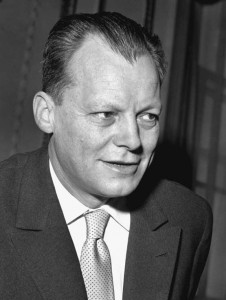On Why the Death of Stuart Hall Is a Loss for our Academy Programs
Stuart Hall, the renowned British cultural theorist and sociologist, passed away exactly one month ago, on 10 February 2014. His death prompted in us a deep sense of personal loss. His groundbreaking writings on cultural studies, in particular on racial inequality, were first translated into German in the mid 1990s—a time when people here were beginning to acknowledge the importance of racism as an issue.

Silent vigil of the Jewish Community at the Putlitz Bridge Deportation Memorial
Photo: Michael Kerstgens, Berlin Tiergarten, 1992
Hall’s approach incited a new discussion and coined a new vocabulary: until then, Germans in the Federal Republic had spoken of “Fremdenfeindlichkeit” (xenophobia), which they regarded as a marginal social phenomenon. Politicians and the media spoke matter-of-factly of society “reaching breaking point” when “the boat gets too full” owing to “Überfremdung.” The latter term denotes the state of ‘being overrun by foreigners.’ It is itself deeply racist and was accordingly voted Non-word of the Year 1993. “Being overrun” was presumed however to be explanation enough for the fire-bombings and other attacks then being carried out almost daily on asylum-seekers’ accommodation centers or immigrants’ apartments—and likewise for the hate campaigns, man-hunts, and pogrom-type riots erupting in Rostock, Hoyerswerda, and elsewhere, or the emergence of no-go areas in other towns and rural centers. In consequence, the law on asylum was altered in 1993 such that judicial opinion held it to have been “de facto repealed.” Therefore, anyone who wished to address the issue of racism as a structural phenomenon and thereby draw on theoretically sound academic sources had necessarily to turn to authors from England, France, the USA, or Canada—and repeatedly to Stuart Hall. → continue reading
Interview with Alexis Hyman Wolff

Alexis Hyman Wolff in her exhibition Zur Zeit at the Museum der Dinge, Berlin, June 2013.
Photo courtesy of the artist.
One of the works in our art vending machine is a candle shaped like a root, made by the artist and curator Alexis Hyman Wolff. In this interview, she offers insight into the development of the work:
Christiane Bauer: Why did you make a candle for the art vending machine?
Alexis Hyman Wolff: Thinking about the small size of the objects and the temporary home they would find in the vending machine, I wanted to reflect on the idea of the souvenir, a central theme in museums. Candles are used for memorial in many cultures. In Jewish tradition, a yortsayt candle is lit to remember a loved one on the anniversary of their death.
What is special about the material you used?
The candles are made out of beeswax from a beekeeping supplier in Berlin. I understand that beeswax is one of the few materials that burn without producing black smoke, which could explain the belief that burning beeswax candles is good for the air. According to a European folk custom, when someone dies, a member of the family must go to the hive and “tell the bees,” and also invite them to the funeral. This tradition suggests a link between bees and the spirit world.
How important is the aspect of “remembrance” in your work? → continue reading
“Hello. My name is Fred Stein, I’m a photographer, left-wing, and I would like to take your picture.”
This is how Fred Stein used to strike up a conversation with people he hoped to portray. Between 1933 and 1967 he managed to make more than 1,200 portraits this way. The words show he had not only the courage to approach people, but also a talent for quickly putting those who had caught his eye at ease.

Willy Brandt, New York 1957
© Estate of Fred Stein
Fred Stein took a passionate interest both in those he portrayed and their work. With André Malraux, Arthur Koestler, Egon Erwin Kisch, and countless other peers he discussed the political landscape in Europe of the 1930 and 40s. Willy Brandt and he became firm friends and remained so all their lives long, and likewise others whose portrait he made. In a letter of 10 May 1983, Brandt recalled:
“I met Fred Stein when we were both refugees and fighting the totalitarian Nazi regime with the rather modest means at our disposal. He was a man ahead of his time, an avant-garde and brilliant photographer, inspired by the commitment to justice and concern for truth so clearly reflected in his photographs. → continue reading


